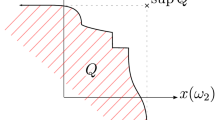Abstract
This paper considers the pricing of multiple exercise options in discrete time. This type of option can be exercised up to a finite number of times over the lifetime of the contract. We allow multiple exercise of the option at each time point up to a constraint, a feature relevant for pricing swing options in energy markets. It is shown that, in the case where an option can be exercised an equal number of times at each time point, the problem can be reduced to the case of a single exercise possibility at each time. In the general case there is not a solution of this type. We develop a dual representation for the problem and give an algorithm for calculating both lower and upper bounds for the prices of such multiple exercise options.
Similar content being viewed by others
References
Aleksandrov N (2009) Multiple optimal stopping: applications in option pricing, liquidation in bond markets and oil extraction. D.Phil. Thesis. University of Oxford
Andersen L, Broadie M (2001) A primal-dual simulation algorithm for pricing multidimensional american options. Working paper. Columbia Business School
Bardou OA, Bouthemy S, Pagès G (2007a) Optimal quantization for the pricing of swing options, Preprint at http://www.arxiv.org/abs/0705.2110
Bardou OA, Bouthemy S, Pagès G (2007b) When are swing options bang-bang and how to use it. Preprint at http://www.arxiv.org/abs/0705.0466
Barrera-Esteve C, Bergeret F, Dossal C, Gobet E, Meziou A, Munos R, Reboul-Salze D (2006) Numerical methods for the pricing of swing options: a stochastic control approach. Methodol Comput Appl Probabil 8: 517–540
Bender C (2009) Dual pricing of multi-exercise options under volume constraints. Fin Stoch. to appear
Carmona R, Touzi N (2008) Optimal multiple stopping and valuation of swing options. Math Financ 18: 239–268
Glasserman P (2003) Monte Carlo methods in financial engineering. Springer, Berlin
Haugh MB, Kogan L (2001) Pricing american options: a duality approach. Technical report, Operation Research Center, MIT and The Wharton School, University of Pennsylvania
Jaillet P, Ronn EI, Tompaidis S (2004) Valuation of commodity-based swing options. Manag Sci 50: 909–921
Keppo J (2004) Pricing of electricity swing options. J Derivatives 11: 26–43
Longstaff FA, Schwartz ES (2002) Valuing american options by simulation: a least-square approach. Rev Fin Stud 5: 5–50
Meinshausen N, Hambly BM (2004) Monte Carlo methods for the valuation of multiple-exercise options. Math Financ 14: 557–583
Rogers LCG (2002) Monte Carlo valuation of american options. Math Financ 12: 271–286
Tsitsiklis JN, van Roy B (2001) Regression methods for pricing complex American-style options. IEEE Trans Neural Netw 12: 694–703
Author information
Authors and Affiliations
Corresponding author
Rights and permissions
About this article
Cite this article
Aleksandrov, N., Hambly, B.M. A dual approach to multiple exercise option problems under constraints. Math Meth Oper Res 71, 503–533 (2010). https://doi.org/10.1007/s00186-010-0310-9
Received:
Accepted:
Published:
Issue Date:
DOI: https://doi.org/10.1007/s00186-010-0310-9




